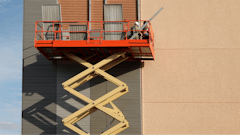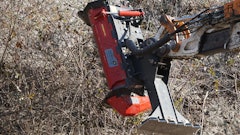
Liam Stannard, chief technology officer with Irvine, CA-based online equipment rental network BigRentz, recently spoke at the ALH Conference & Awards in Miami about the future of equipment rental and how BigRentz is helping to bring the industry into the sharing economy. We sat down with him to talk about his point of view. The following is edited from that discussion, as well as his presentation.
Rental: BigRentz has been around for five years now and is growing steadily. How does your business model work?
Stannard: We’re not a traditional rental company. Think of us more as a virtual rental company. We don’t own any assets. When a company rents from us, we in turn rent from brick and mortar rental companies near our customer’s location.
Because we’re online only, we understand that having a strong partnership with our rental company partners, whom we call suppliers, is crucial. We’re in this to build a durable business and the only way we can do that is if it’s a win-win for everybody. Today, we’re proud to say we have over 8,000 rental yards from 1,500 rental companies around the country signed up as partners. We want to do a great job for our customers, but we know it’s crucial that we empower our partners.
Rental: How does this change the game of equipment rental?
Stannard: As a technology company, especially one that owns no fleet, it’s been about figuring out the customer angle and figuring out the supplier angle, and using technology to make everyone’s lives better.
A lot of our customers might rent thousands of times in the US and they might work with dozens of rental companies, depending on their geography. Being able to provide that type of customer a one-stop shop, where they can make one call, or one click, and get all their needs met, has been an important part of our recent evolution.
At the same time, we’ve been providing our rental company partners with virtual capex. We’re nationwide, and we have tremendous insight into the market. So our rental company suppliers might have a customer that says, hey I’ve got a job over there, can you help me? Maybe they’re a small player and they don’t have a yard in that area. In the past, they would have had to say no, or make some calls to other branches or even competitors to find the equipment. This search for equipment is a distraction, and in some cases, rental companies can forget about the re-rent while it sits at the customer’s project site despite their own gear coming available.
We also provide data and info to help our partners make better decisions, to help them capture opportunities in the market they might not have seen. We’re a tech company, so we track literally everything - every phone call, every visit to our website, all of our interactions - and we provide that data back to our partners. This can really help for fleet planning, but we also provide a broader perspective on the market because we work in every state in the union, and sometimes in Canada and Latin America.
Rental: Can any size and type of rental company be a BigRentz partner?
Stannard: We work with single-branch businesses all the way up to United Rentals.
Rental: Who is the typical BigRentz customer?
Stannard: There are really two types of customers - we have rental companies that are using us for capex and we have renters who are just not well served by the traditional rental company, maybe because of geography, if they have multiple jobsites across the country, for example. Logistics becomes a challenge in that case. So rather than making a call to a bunch of regional rental outlets, piecing things together themselves in one city and then doing it again in another city, they can make one call to us and we can provide all of their needs. Because we’re that single point of contact and we understand the full span of their job, when things change, we can be very flexible.
Rental: Mobile technology is becoming increasingly more important in equipment rental. How often are customers going straight to their mobile devices and working rentals out that way vs. making a phone call?
Stannard: We’ve been blown away by the adoption of our mobile technologies. But, you can give us a call or send us a text too, all of those things are totally fine.
There’s a generational element to this. Millennials, for example, expect an online experience. That’s just how they do business.
Rental: We hear a lot about millennials. Tell us how they’re changing the way we do business.
Stannard: Studies show that more than a third of millennials say they don’t want to do business face to face. They prefer online collaboration. So, while the relationship model that has worked before makes a lot of sense, on the flip side, today’s decision-makers have a different baseline expectation of what that is.
According to the US Bureau of Labor statistics, millennials (who were born between 1981 and 1996) are currently the single biggest generation in the workforce. But in just a couple years they’re going to be 75 percent of the workforce. The reason this is so crucial to understand is millennials have a fundamentally different relationship with technology than Gen X or Boomers do.
Last year, almost 11 percent of all retail sales were done online to the tune of $340 billion. In just a couple of years, analysts tell us half of all e-commerce is going to be done on a smart phone. If you consider millennials and technology, it’s fair to say they want to find what they need online and frankly, they want to find it right now.
Rental: How can this be good for the rental industry?
Stannard: I was recently talking to a regional contractor and he’s a millennial and taking over his family’s three-generation business. He told me that since taking over, he’s been looking deep into the numbers and what he’s found is that the competitive advantages his dad and his grandad had when running the business don’t really apply anymore. Back in the day, contractors had to own their own equipment. From what this COO told me, he currently owns $4 million in construction fleet, but mechanics are incredibly expensive, the fleet is super underutilized and even the real estate to have as a lay-down yard is a tremendous allocation of capital. He told me his plan is to sell all of his equipment over the next 18 months. And that sort of thinking is going to drive an increase in rental penetration across the industry. As more folks understand, owning equipment as a contractor just doesn’t make a whole lot of sense right now.
At BigRentz, we drive revenue and increase utilization by renting assets from our partners, but moreover, we bring new customers and new customer segments to our rental company partners.
Rental: Are we headed toward an Uber for Boom Lifts scenario?
Stannard: Let’s talk about what an Uber for Boom Lifts might look like: Somebody owns a Z-80 and they want to rent it. They download an app on their smart phone and they put their Z-80 up for rent. Somebody else wants to go up in the air, so they have the Uber for Boom Lifts app, and they’re connected. Simple! So why not scissor lifts, knuckle booms, telehandlers, etc.? The thing about it that many outside our industry don’t realize is that this is complicated. Say you’ve rented to some guy on the internet… who’s going to take him up in the air? Is the guy who owns the asset going to do it? Is the customer going to do it? Is the customer qualified?
With the Uber game, drivers are very comfortable having some random stranger in the back of their car. But how many of us would be comfortable leaving a $100,000 asset with some random guy from the internet?
Rental: If it’s not the Uber model, what will work to bring the equipment rental industry into the sharing economy?
Stannard: You could become a tech company and you could develop, build, market, support and maintain your own mobile application or customer portal. A lot of the large, nationwide rental companies are going to do this as a necessity. No matter how it’s done, it’s going to cost easily hundreds of thousands if not millions of dollars. But let’s remember the lessons from the first dot.com crash - technology is not magic fairy dust. You don’t just sprinkle it on your business and watch amazing things happen. It’s really crucial to keep your customers in mind. This is so important to get right because it’s so incredibly expensive if you get it wrong.
Think about the fragmentation in our industry. Nobody has more than 15 percent market share. Again, when you think about your customers, ask yourself if they will be excited about having multiple apps, one for each of the rental companies they work with? All customers of any size work with between three and seven rental companies. Are they going to be excited about having multiple user names and passwords, and different ways to go about things?
So, you can become Uber or a tech company, or you could take a third path and partner with a technology company to get the best of both worlds. This means finding the right partner that’s able to drive customers to you that hopefully and ideally are not your core customer. When you find the right partner, hopefully, they can help you streamline your operations in different ways. We have the capex replacement product to get gear to rental companies when they don’t have it. We also have data, which is super important.
Rental: What do you see in your crystal ball for the industry?
Stannard: The trend is clear, our customers are going online. Let’s face it, everybody and their grandma has a smartphone. Today’s young decision-makers expect and demand to find what they’re looking for online. Our challenge as an industry is to meet that demand.
But there’s no right answer here. There’s not a one-size-fits-all approach. You’ve got to figure this out for yourselves. As you’re contemplating how to tackle online rental, I’d encourage you not to look at this as a disruption to your business model. Instead, look at this as an opportunity to increase revenue, increase margins, find new customers and serve all your existing customers more effectively. The future in our industry is bright and online technology is going to play a major part in driving growth. However it is you get there, your customers and I look forward to seeing you online.
Rental businesses interested in partnering with BigRentz can visit www.bigrentz.com/suppliers/




























